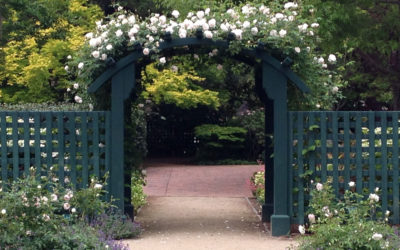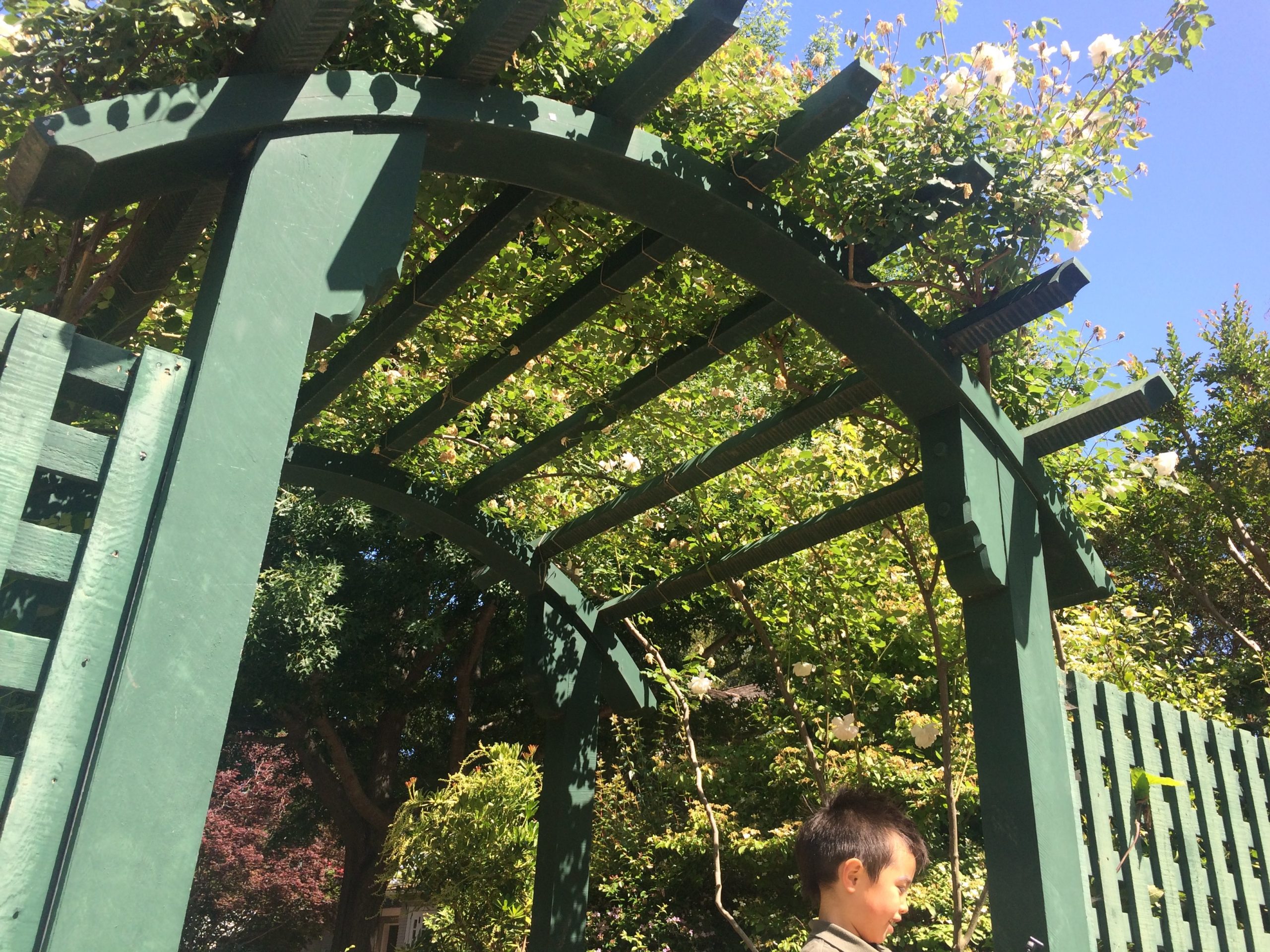
This article was published in Gamble Garden’s Member Newsletter in the spring of 2013. Originally titled “Introducing Gamble’s New Garden of Old Roses“, the article was written by Betsy Fryberger on the occasion of the reopening of Gamble’s Rose Garden. The Rose Garden began a multi-year, multi-fund, multi-expert renovation, from late 2010 to early 2013.
Welcome to the new garden of old roses, which was planted in the spring of 2011. Although still young, the roses are growing rapidly, climbers reaching up the historic green fence and shrubs filling in the foreground. The central circle of white “Iceberg” roses has just been replaced.
The rose area is more visible and welcoming, no longer masked by a high hedge. “Madame Alfred Carriere”, an old Noisette of unknown parentage with fragrant white blossoms touched with pink, has begun to cover the newly constructed entrance arbor.
What were the reasons for singling out each of these more than 30 roses? Each rewards in multiple ways: individual beauty, fragrance, historical interest, and sound health. For example, “Fortune’s Double Yellow” was discovered in China by the Scots plant hunter Robert Fortune and brought to England in the 1840’s. As the first rose with a yellow tint introduced into the trade, it became enormously popular, helping earn the intrepid Fortune, who helped establish the tea trade in India, some of his fortune. This once blooming rose, also known as “Beauty of Glazenwood” and “Gold of Ophir”, scrambles over arbors, even houses, smothering them with blooms.
The fascinating history of roses is complex, often not agreed upon, or fully understood. The Romans grew Gallicas; ‘Autumn Damask’ came from Damascus, probably reaching Europe during the Crusades; and Rugosas with their crinkly leaves are native to Japan. During the 19th century, reblooming roses from China made possible new hybrids. The Gamble selection includes old rose species, such as Albas, as well as 19th century hybrids.
In the 1940s when Miss Gamble gardened, she planted the then popular Hybrid Teas, among them the white “Ophelia”, which is again back in the garden. In recent decades, Hybrid Teas’ susceptibility to disease and lack of fragrance has diminished their allure. Many hybridizers, conspicuously David Austin, have worked to develop intense fragrances in disease-resistant plants.
Roses through their beauty and fragrance have inspired writers, artists, musicians, and such innovative gardeners as Gertrude Jekyll and Vita Sackville-West. At Malmaison, Empress Josephine’s garden outside of Paris, the gifted botanical artist Pierre-Joseph Redoute painted its many roses. Close to one hundred hand-colored engravings after his designs were published from 1817 to 1824, bringing fame to that garden and to the genus Rosa.
The new Gamble Garden rose selection celebrates the rose’s diverse ancestry, not its most recent (and obvious) past. Mary Jane Tapp and Gwen Whittier of Gamble Garden’s Garden Committee initiated the replanting of the roses. Betsy Clebsch, William Grant, Barbara Worl, and myself joined them in choosing the new roses. The Garden Club of Palo Alto and others generously provided funds that made it happen.
Learn more about roses in books or online. Gardens are for learning, as well as relaxation and reflection. Let Gamble’s new old rose garden inspire you — even to introduce changes to your own rose garden.
